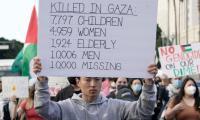As I sit down to write this column with a very heavy heart, there are bombs going off at some distance. Although I feel I might be away from harm’s way, at least for now, the loud bangs are rattling the window panes with a ruthless nonchalance that provokes a familiar dread of a carnival of terror.
Ever since I came back to Kashmir in June this year, there has been an unending spree of death visiting almost every part of this unfortunate place. I have lost count of how many people have perished so casually, apparently in ‘encounters’, turning the word that once exuded romance in my imagination into the standard vocabulary for violent death that is provoked and meted out by the militarised state apparatus that has entirely securitised our milieu and turned everything scarlet red.
Earlier in the day, in late afternoon, news came that military personnel in search of resistance militants had laid a cordon at a nearby village, Arwani, barely three kilometres from my house. Within an hour we got a grim update that they had been killed. This is a familiar story, the military personnel aided by paramilitary forces and the local police who often work in tandem after they pinpoint the precise militant location that is usually some civilian house.
The unofficial standard operating procedure that is in vogue is simple: destruction of the building through explosive materials and incessant heavy firing, grenade and mortar shelling. This leaves little to no chance for resistance by the holed-up ‘militants’, who are often untrained or barely trained even though they carry assault rifles and a nominal supply of ammunition. There is hardly any effort to disarm them or seek their surrender; their death is linked to a whole regime of undue promotions, outside-of-the-norm medals, national awards, cash prizes, and departmental appreciation.
As evening fell, I went outside for a stroll – much against the advice of my septuagenarian mother who shouted her discomfort at my decision with a nearly hysterical pitch. But I wanted to get out since I had been cooped up inside for the whole day sans any internet and therefore, no reliable means of communication with the outside world. The road outside was fearfully deserted. After a few paces, I was seriously thinking of going back to the security of my compound when a friend and a neighbour shouted from nowhere. In a few minutes we attracted a bunch of other forlorn spirits and learnt a little more about today’s ‘encounter’ – two militants had been killed as soon as the siege had commenced. After a few minutes, I thought about the immobilising anxiety of my mum and the silent fright in my son’s eyes and so I hastened back home.
Now as I sat down to write this piece, loud bangs started to issue from a distance. Their intensity and the terror they engender are quite unsettling. “Another ‘encounter’ must have started somewhere nearby”, I think to myself. It was not long that a pro-India politician friend and a senior leader of the National Conference called to tell that four militants were killed in Arwani. There was a certain kind of sadness in his voice as he remarked, “we are being killed like flies”. I sighed and blamed his party for the mess and the continued human tragedy that ceaselessly consumes generation after generation without any end or hope of an end to it.
Our home internet has been miraculously restored and I am lapping up news about the incident. The police version offers a standard blurb that has now become so blasé that it hardly evokes any emotion. “At Khar Mohalla of Arwani in Bijbehara district Anantnag, police and security forces launched a cordon and search operation based on credible input about the presence of the militants in the area. As the search operation was going on, hiding militants fired upon the search party, which was retaliated leading to an encounter.
“In the ensuing encounter, four militants were killed. The identity of the killed militants is being ascertained. Incriminating materials including arms and ammunition were recovered from the site of encounter. Police has registered a case in this regard and investigation has been initiated in the instant matter. Citizens are once again requested not to venture inside the site of encounter since such an area can prove dangerous due to stray explosive materials.”
Two days ago, Sabzar Sofi, a PhD scholar in botany, who had joined resistance militant ranks almost two years ago, was killed in a similar encounter in Srinagar alongside a colleague-in-arms. Sabzar was from Naina, Sangam, a place not so far from my hometown, Bijbehara. According to newspaper reports, Sabzar was committed to intellectual pursuits and keen to find a career within the academic field or the Indian civil services. But in the brutal aftermath of Burhan Wani’s killing in July 2016 in which hundreds of youth were killed and thousands blinded, he was pushed to take up arms and offer a fight. While this fight is largely symbolic, given the massive asymmetry of power, but it is a fight nonetheless, and laced with a very potent message of defiance.
A few days earlier, another PhD scholar Mannan Wani was killed in a similar set of circumstances. Mannan too was inclined towards higher intellectual rigour and inquiry but the continued tragedy at home forced him to abandon his career and intellectual ambitions to choose a more direct form of engagement with the brutal state architecture.
Though Kashmir is always in mourning as more youth fill the spaces at martyr’s graveyards, this month has been deadly with nearly 50 people, mostly youth, being killed and buried. Just today’s death count in various ‘encounters’ reached a dozen. Two days back, it was half a dozen. Four days earlier, it was another half a dozen civilians killed in a bomb blast at an ‘encounter site’ in Kulgam, a nearby district. And the relentless march of death continues.
Twitter: @murtaza_shibli
Earth Day protests carry a vital message that is relevant 365 days a year. — AFP File Earth Day is celebrated every...
People walk along a market in Lahore on May 17, 2023. — AFP/FileMany of us had hoped that the general election...
Packs of freshly printed $20 notes are processed for bundling and packaging at the US Treasury's Bureau of Engraving...
People stand in line up as election officials check their ballot papers during voting general election at a polling...
Women show their voter identity cards as they stand in a queue before casting their votes in Agartala. — PTIThe 18th...
Former prime minister Imran Khan. — Instagram/ imrankhan.ptiAn old saying has it that “when you dance with the...







